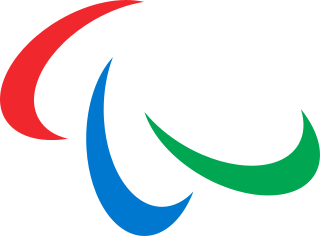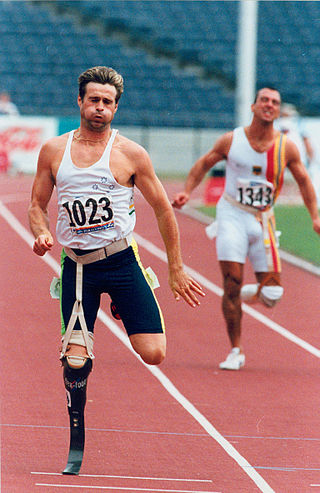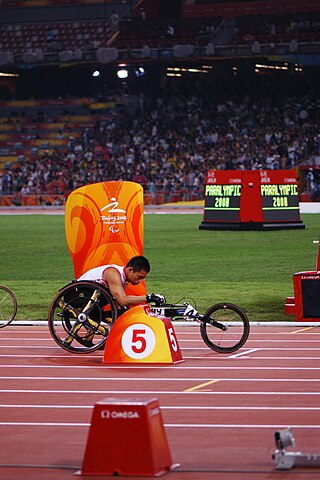Related Research Articles

The Summer Paralympics, also known as the Games of the Paralympiad, are an international multi-sport event where athletes with physical disabilities compete. This includes athletes with mobility disabilities, amputations, blindness, and cerebral palsy. The Paralympic Games are held every four years, organized by the International Paralympic Committee. Medals are awarded in every event, with gold medals for first place, silver for second and bronze for third, a tradition that the Olympic Games started in 1904.

2 point player and 2.5 point player is a disability sport classification for wheelchair basketball. People in this class have partial trunk control when making forward motions. The class includes people with T8-L1 paraplegia, post-polio paralysis and amputations. People in this class handle the ball less than higher-point players. They have some stability issues on court, and may hold their wheel when trying to one hand grab rebounds.
3-point player is a disability sport classification for wheelchair basketball. People in this class have good forward and backward trunk movement but poor to no sideways trunk movement. The class includes people with L2–L4 paraplegia and amputations. Amputees are put into this class generally if they have hip disarticulations or hip abductions. Players in this class can generally rebound balls that are over their heads, but they can have some issues with balance during lateral rebounds.
T35 is a disability sport classification for disability athletics' running competitions. It includes people who have coordination impairments such as hypertonia, ataxia and athetosis. This includes people with cerebral palsy. The classification is used at the Paralympic Games. The corresponding F35 classification includes club and discus throw, shot put, and javelin.

T44 is a disability sport classification for disability athletics, applying to "Single below knee amputation or an athlete who can walk with moderately reduced function in one or both legs." It includes ISOD A4 and A9 classes.

T53 is disability sport classification for disability athletics. The class includes people with a number of different types of disabilities including spinal cord injuries. People in this class have full use of their arms but have no or limited trunk function. Similar classifications are T51, T52, and T54. People in this class have a functional upper limbs, but limited trunk usage and limited lower limb functionality. During classification, they both undergo a bench test of muscle strength and demonstrate their skills in athletics. People in this class include Tanni Grey-Thompson (GBR), Samantha Kinghorn (GBR), Angie Ballard (AUS) and Richard Colman (AUS).
ARW1 is a Paralympic archery classification. It is a sitting class. This class includes Les Autres sportspeople. People from this class compete in the sport at the Paralympic Games.
ARW2 is a Paralympic archery classification.
ARST is a Paralympic archery classification. It is a standing class. This class includes Les Autres sportspeople. People from this class compete in the sport at the Paralympic Games. Some people in this class can use stools or have an assistant nock their arrows. Classification is handled by FITA – International Archery Federation.
BC1 is a Paralympic boccia classification. The class is open to people with several different types of disabilities, including cerebral palsy. BC1 players have events open to them in boccia on the Paralympic Games program.
BC2 is a Paralympic boccia classification. The class is open to people with several different types of disabilities, including cerebral palsy. BC2 players have events open to them in boccia on the Paralympic Games program.
C3 is a para-cycling classification. The class includes people with moderate upper or lower limb dysfunctions and includes cyclists with cerebral palsy, limb impairments and amputations. The UCI recommends this be coded as MC3 or WC3. The class competes at the Paralympic Games.
HCA is a para-cycling classification.
HCB is a para-cycling classification.
HCC is a para-cycling classification.
LC1 is a para-cycling classification. It includes a number of types of people with disabilities including people with amputation and spinal cord injuries that are mostly confined to the upper limbs. This class includes people from the ISOD A5 class, A6 class, A7 class and A8 class.
Wheelchair fencing classification is the classification system for wheelchair fencing which is governed by the IWAS. People with physical disabilities are eligible to compete included people with physical disabilities. Classification for national competitions is done through the local national Paralympic committee.
Para-equestrian classification is a system for para-equestrian sport is a graded system based on the degree of physical or visual disability and handled at the international level by the FEI. The sport has eligible classifications for people with physical and vision disabilities. Groups of eligible riders include The sport is open to competitors with impaired muscle power, athetosis, impaired passive range of movement, hypertonia, limb deficiency, ataxia, leg length difference, short stature, and vision impairment. They are grouped into five different classes to allow fair competition. These classes are Grade I, Grade II, Grade III, Grade IV, and Grade V(Grade Names Changed as of Jan 2017). The para-equestrian classification does not consider the gender of the rider, as equestrines compete in mixed gender competitions.
Class A is a Paralympic wheelchair fencing classification.
F55 is a disability sport classification for disability athletics for people who compete in field events from a seated position. Sportspeople in this class have full arm function, partial trunk function and no lower limb function. Different disability groups compete in this class, including people with spinal cord injuries. The classification was previously known as lower 3, upper 4.
References
- 1 2 "A-Z of Paralympic classification". BBC Sport. 28 August 2008. Retrieved 9 April 2012.
- ↑ "Making sense of the categories". United Kingdom: BBC Sport. 6 October 2000. Retrieved 9 April 2012.
- ↑ "Guide to the Paralympic Games – Appendix 1" (PDF). London Organising Committee of the Olympic and Paralympic Games. 2011. p. 41. Archived from the original (PDF) on 26 April 2012. Retrieved 9 April 2012.
- ↑ "Rio 2016 Classification Guide" (PDF). International Paralympic Committee. March 2016. Archived from the original (PDF) on August 16, 2016. Retrieved July 22, 2016.